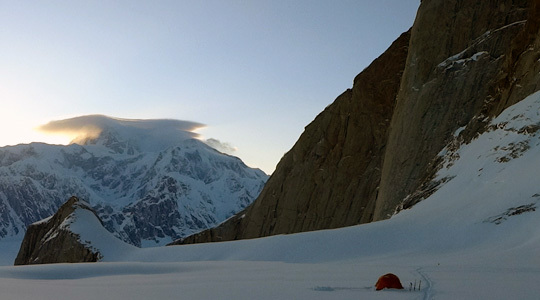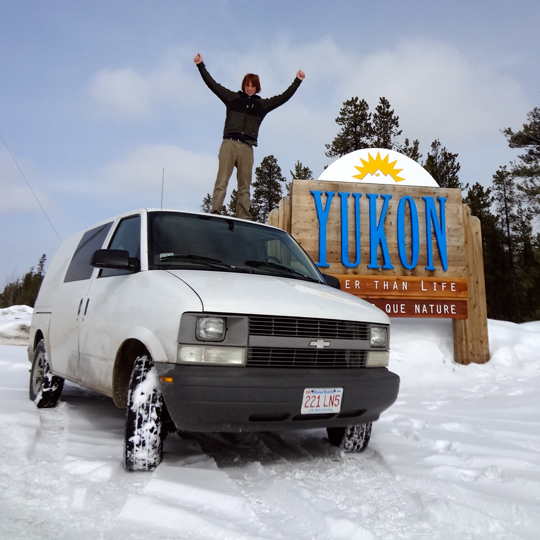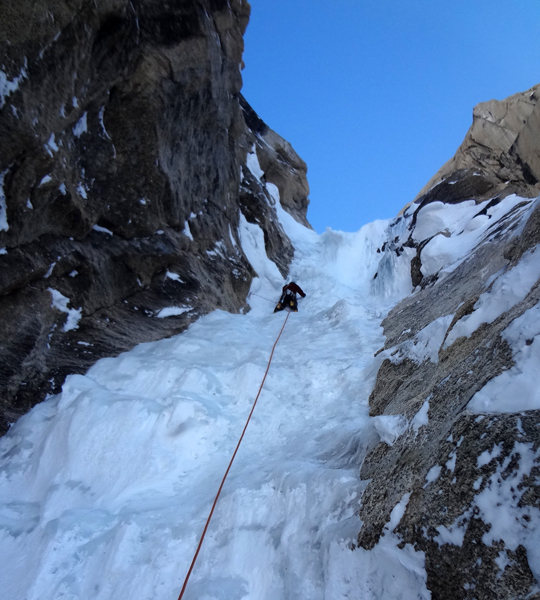
“Hey Roger, how’d it go up there?”
I don’t even have to ask. Only a couple hundred feet of placid glacier separates Roger and Fabrizio’s tent from mine, and I couldn’t help but hear them rehashing their day. In fact, it’s hard not to overhear each one of their (usually hilarious) conversations in our small camp.
“We fixed one of our ropes on Pitch 2 so you can have something to yard on while you wade up the snow,” he said. “And our rack is in a bag at the bottom of Pitch 1; we left our biggest cam on top of it in case you don’t have one. A five would be perfect, but a tipped-out four works, kinda.”
Now we’re fixing rope and using gear caches on a route famous for its alpine-style first ascent?
Officially, we were siege-ing a relatively easy trade route, Ham and Eggs, on the Ruth Gorge’s Mooses Tooth massif. Twenty days ago, my longtime friend Paul and I left New Hampshire in my Chevy Astro work van, packed to the gills with ultralight hardware, superlight ropes, hyperlight bivy gear and a pair of heavyweight egos. Now these siege-style tactics were throwing water on the incense burning in front of my framed photograph of John Bouchard. Suddenly, I found myself at an utter loss for Mark Twight quotations.
When Paul and I–plus Fabrizio and Roger–were dropped off at the barren Root Canal airstrip below the Mooses Tooth we were met by some stupidly cold conditions. It was like being back on Denali each night. I donned all of my layers and prepared my face to do battle with the frost daggers about to form on the cuff of my sleeping bag. After days of waiting, the weather was almost warm enough for a sane person to get out of the tent before the sun hit. Paul and I “graciously” let Fabrizio and Roger have a go at Ham and Eggs first. They were, after all, real climbers, and we made sure they knew how far apart we like our steps kicked.
But the extreme cold and recent precipitation also meant lots of unconsolidated snow. When we emerged from our tents at 11 in the morning, we saw that our new friends already stymied by Pitch 3 of 17! The wind carried their string of frantic commands and some creative expletives towards us as Fabrizio hacked furiously at snow-plastered rock just right of where the route was supposed to go. “I hope all that snow he’s sending down doesn’t mess up the boot pack they’re putting in for us.”

After hours of watching, Paul and I conceded that not only would there be no perfect staircase in the snow for our attempt the next day, but it was unlikely we’d get very far at all: Their report when they return that a huge snow mushroom was choking off a chimney, but there appeared to be a crack to its right that could get us over it, maybe. Nervous, Paul and I added what felt like 20 pounds of iron and aid trinkets to our rack. “So much for going ultra light!
A FEW MORNINGS AFTER ROGER AND FABRIZIO’S ATTEMPT, the sun is rising and, above me, my 22-inch picket is shoved sideways into the unconsolidated underbelly of the snow mushroom. A piton leftover from Nate Zinsser, Tom Davies and Jon Krakauer’s 1975 first ascent is the only gear around, and I’m pretty sure the way it wiggles isn’t a design element. Shaking my head in disbelief, I carefully snake my crampon through the aider clipped to my picket, and weight it slowly. The picket feels better than expected, and as I commit my weight to it, I swing gently out over the void. And then, kaCreeeeak! The picket pivots sharply downwards and slides out eight inches, miraculously catching on… something. Gingerly, I reach out a leg and stab my frontpoints back in under the mushroom, step down out of my aider, and exhale.
Abandoning the direct line of attack, I follow Fabrizio’s path up an ice-choked crack to the right, where decent placements lurk beneath three inches of hard snow. From Fabrizio’s highpoint, I hack with the ferocity of a lumberjack to clear snow from rock. A baby angle, the big cam, a nut, cam hook, some more nutting, and I’m at the end of the crack, my hip level with the top of the snow mushroom. Hanging sideways from my daisy, I chop a small platform into its bulbous apex, the snow feeling far too soft for bodyweight. Thinking light thoughts, I unclip my daisy, step out of my aiders and swing onto the mushroom. Everything is still, and I don’t dare breathe. Then suddenly, I sink–fast!
I’m bracing for the fall, but the mushroom ice stops swallowing me at crotch-level. With some cautious digging and groveling, I’m move off of it. I try to let out a howl, but my throat is too dry to make a sound. Instead, a cacophony of yips and cheers from below pound and echo into my ears. The entire camp is gathered on the airstrip a few hundred feet below, watching me climb.
Soon we descend to base camp, where a bouquet of a half-dozen orange and yellow tents has sprouted since the morning. And everyone’s gunning for Ham and Eggs, one of the few moderate routes in climbable conditions this season. Antsy climbers shuffle around camp in their down booties, checking to see who’s in line ahead of them for the route and who has a big cam to borrow. Now we are truly evoking the humongous, many-member expeditions of old.
The next day, Fabrizio and Roger make progress clearing off a hardened veneer of ice over snow from the route’s traditional crux on Pitch 7. Following this, we make way for our enthusiastic and optimistic new neighbors, Celena and Brain, to take a run at the route. Incredibly, after re-cleaning cracks and wading through newly fallen snow all day long just to gain a few pitches, they return to camp with smiles still on their faces.

Finally, Paul and I get our chance to go for the top. Standing on the shoulders of our newfound friends, we are able to move quickly up the first half of the route, saving us time to deal with more scrappy conditions in the Narrows above. Hacking, cleaning and digging through deep snow and snice turns out to be far harder than the actual climbing. We excavate trenches up the sides of the couloir to locate old fixed anchors; twice, I fall directly onto rappel stations when I sink up to my armpits in the snow.
Like miners emerging from the mineshaft after a long day of work, we trudge to the col atop the route. Paul is in no mood for the summit, and we bail. But as we rig our first rappel, two strong climbers drafting in our tracks cruise by, en route to the main summit of the Mooses Tooth. “Yo, thanks!” they shout through massive grins, glad for the boot pack and the uncovered anchors as they head to the top.
Back at camp in the morning, commotion is brewing as the climbers who went to the main summit return. One has some bad frostbite on his toes, and the camp community seems to come to life yet again to help. A friendly doctor organizes the gathering of supplies to pad the foot and bathe it in warm water, while others carry the injured climber’s duffels and packs down to the airstrip so that he can be flow back to town.
Though only a single rope was fixed for just a single day, our siege was still successful for its spirit of tenacity, patience amongst teams and damn hard work. In a world where shirtless dudes in beanies get in fistfights over who’s been projecting a boulder problem longer, this kind of camaraderie is, in itself, an achievement. Ambitious climbers with fixed timelines who had spent thousands of dollars to be there, shared gear, beta, food, water, whiskey and psych, each putting aside his and her own agenda, for the good of all.
As I depart our Root Canal camp, I write my name and number on a slip of paper on my biggest cam and leave it with friends I’d met just a couple days before, not caring that I might never see it again. I’m even less certain of seeing such a perfect little community coexisting on a glacier.